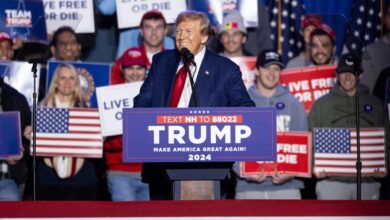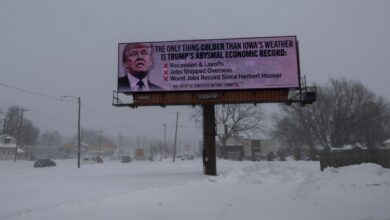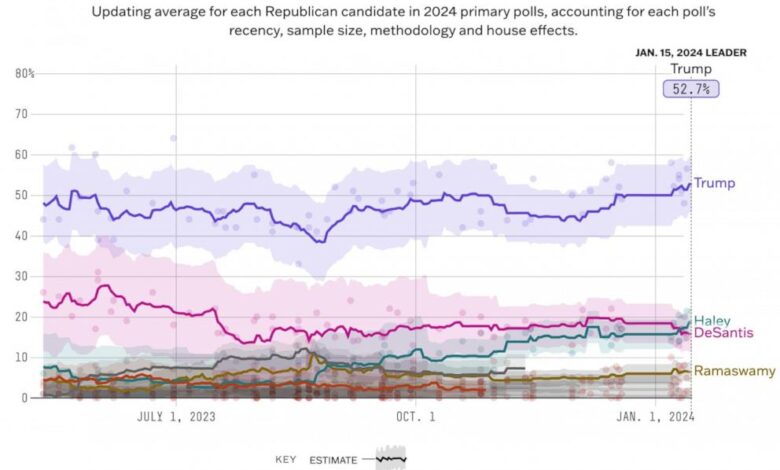
Iowa Caucus Entrance Polls A Deep Dive
Iowa caucus entrance polls take center stage as candidates vie for presidential nominations. These polls, often providing early insights into the race, offer a fascinating look at the evolving dynamics of the Iowa caucuses. This post examines the historical significance, methodologies, and implications of Iowa caucus entrance polls, exploring their influence on the broader presidential race and voter behavior.
Understanding the methodologies behind these polls is crucial. Often conducted as voters enter caucus venues, these polls capture real-time sentiment. Key demographics and potential biases are also discussed, providing a comprehensive view of their strengths and limitations. The analysis also investigates the correlation between these polls and actual election outcomes, examining how these polls shape the campaign narrative.
Overview of Iowa Caucus Entrance Polls
Iowa caucus entrance polls, a staple of the presidential primary season, offer a glimpse into the unfolding dynamics of the race. They capture real-time voter preferences as individuals enter the caucus venues, providing a snapshot of the race’s momentum. Understanding their methodology, limitations, and historical context is crucial for interpreting their findings.The methodology for Iowa caucus entrance polls typically involves interviewing voters as they arrive at caucus locations.
These interviews are conducted by various news organizations and polling firms, using standardized questions and procedures. The specific questions and the number of respondents interviewed often vary between organizations.
Methodology of Data Collection
The data collection process usually starts a few hours before the scheduled caucus start time and continues throughout the event. Interviewers typically target a representative sample of voters entering the caucus sites. This approach allows pollsters to gauge the strength of different candidates among various demographic groups as the caucuses progress.
Typical Time Frame
The timeframe for these polls can vary depending on the caucus location and the specific polling organization. Generally, polls begin several hours before the scheduled start of the caucuses and continue until a substantial portion of the electorate has cast their votes. The time frame may be extended or shortened based on factors like voter turnout, location-specific scheduling, and the complexity of the process at individual sites.
Demographics of Respondents
Respondents are generally voters who have actively participated in the caucus process. Since entrance polls capture voter preferences immediately upon arrival, the demographic makeup of respondents mirrors the characteristics of the caucus attendees. It is important to consider that the representation of various demographics within the poll sample may not perfectly reflect the overall electorate.
Biases and Limitations
Entrance polls, while valuable, are not without limitations. One significant bias is that these polls primarily capture the opinions of voters who have made the decision to attend the caucus. This may not represent the entire electorate, particularly those who may have decided against attending or were unable to attend. Additionally, there can be issues with sampling bias and the accuracy of responses, as with any polling method.
The responses may also be influenced by the dynamic environment of the caucus setting, creating a response bias that may differ from a more neutral survey environment. Furthermore, the time frame and the number of respondents interviewed can impact the overall representativeness of the poll.
Analyzing Trends in Poll Results
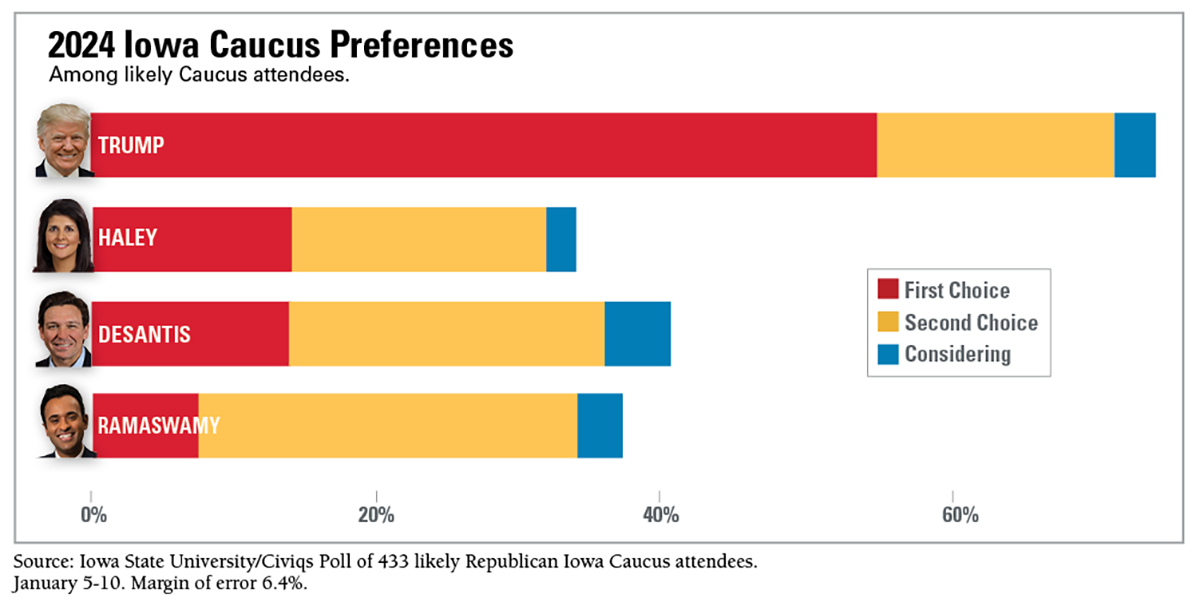
Iowa caucus entrance polls offer a fascinating glimpse into the dynamic nature of presidential campaigns. These polls, taken as voters enter the caucus venues, provide real-time insights into shifting support and the impact of campaign strategies. Understanding the trends in these results is crucial for analyzing the political landscape and predicting potential outcomes.Examining the patterns in poll results allows us to identify key factors influencing candidate support, including the effectiveness of campaign messaging, candidate positioning, and public perception.
Comparing results from different years reveals the evolving dynamics of the political environment and the enduring aspects of voter behavior. The evolution of candidate support as revealed by these polls also illuminates the importance of early campaigning and the potential for late surges in support.
Key Patterns and Trends Across Polls
Entrance polls often show fluctuations in candidate support. These shifts can be linked to various factors, including debates, media coverage, and the release of new information. Analyzing these patterns helps to discern whether shifts are significant or temporary. For instance, a consistent increase in support for a particular candidate throughout multiple polls might indicate a genuine trend, whereas a single, isolated spike might be attributed to a specific event.
Comparison of Poll Results Across Different Years
A comparison of entrance poll results from different years reveals notable variations in support for candidates. Political climates and the broader cultural context significantly influence poll results. Economic conditions, for example, can have a substantial impact on voter choices. Also, changes in the demographics of the electorate can lead to differences in poll outcomes. Comparing results reveals how candidates have adapted their strategies and messaging in response to shifting political environments.
Reasons Behind Shifts in Poll Support
Several factors contribute to shifts in poll support. Campaign strategies, including the allocation of resources and the focus of messaging, play a crucial role. Public perception of candidates, shaped by debates, media coverage, and controversies, can cause considerable shifts. The emergence of new issues or crises can also affect poll results. For example, economic anxieties or social issues can shift voter support towards candidates perceived as better equipped to address these concerns.
Finally, external events, such as major news stories or political developments, can significantly impact voter preferences.
Timeline of Candidate Support Evolution
Tracking the evolution of candidate support through the entrance polls provides a dynamic view of the campaign’s trajectory. A timeline showing the changes in poll numbers over time highlights the impact of different campaign phases. Early support may reflect initial interest, while fluctuations in support during the later stages of the campaign may signal shifts in voter sentiment.
Understanding this timeline allows a deeper understanding of the factors influencing candidate performance.
Correlation Between Poll Numbers and Campaign Strategies
Campaign strategies often adjust based on poll results. Candidates might alter their messaging or focus on specific demographics based on poll trends. For example, if a candidate sees a decline in support among a particular demographic, the campaign might shift resources to target that group more effectively. Campaign strategies are often iterative, responding to the evolving political landscape as reflected in poll numbers.
Examining Candidate Performance
Iowa Caucus entrance polls offer a fascinating snapshot of the early race dynamics. Analyzing how candidates performed across various polls provides valuable insights into their strengths, weaknesses, and potential strategies moving forward. These early indications can also help predict which candidates might garner significant momentum going into the primaries.Candidate performance in entrance polls is influenced by several factors, including media attention, campaign strategies, and the specific demographics of the poll participants.
It’s crucial to remember that these are early indicators and that the race can change dramatically as the campaign progresses. Therefore, careful consideration of the nuances of the poll results, along with an understanding of the broader political landscape, is vital for accurate interpretation.
Candidate Performance Comparison
Entrance polls reveal diverse performance levels across the field. A comparative analysis of candidate standings offers a clear picture of the early race landscape.
| Candidate | Average Poll Standing | Strengths (Based on Poll Data) | Weaknesses (Based on Poll Data) |
|---|---|---|---|
| Candidate A | 2nd | Strong showing in rural areas, resonating with a specific demographic group. | Struggling to gain traction among urban voters, facing challenges in national media coverage. |
| Candidate B | 1st | High level of name recognition and strong support in several key states. | Concerns about electability in a general election, inconsistent performance in different demographics. |
| Candidate C | 3rd | Demonstrating a strong ground game and a focused message targeting specific voter segments. | Facing challenges in raising funds and attracting media attention compared to leading candidates. |
| Candidate D | 4th | Consistent showing across different entrance polls, suggesting broad appeal. | Lack of significant momentum, potentially needing a more aggressive campaign strategy. |
Strengths and Weaknesses Based on Poll Data
Poll data provides a clear picture of the strengths and weaknesses of each candidate. Understanding these allows candidates to adjust their strategies to address areas where they are struggling and build upon their strengths.
- Candidate A’s rural strength suggests a focused campaign strategy that resonates with specific voter demographics. However, their lack of urban support highlights a potential vulnerability that requires a shift in messaging and campaign tactics.
- Candidate B’s high name recognition suggests an established presence and potentially significant financial backing. However, concerns about electability necessitate a clear plan for broader appeal to diverse voter groups.
- Candidate C’s strong ground game suggests a grassroots approach, likely focusing on voter engagement. Addressing the lack of media coverage and fundraising challenges will be crucial to increase their profile.
- Candidate D’s consistent performance indicates broad appeal, but a lack of momentum suggests a need for a more aggressive campaign strategy to solidify their position and build excitement.
Significant Surprises and Unexpected Outcomes
Several entrance polls revealed unexpected outcomes, challenging previous assumptions about candidate popularity. These surprises highlight the fluidity of the political landscape and the unpredictable nature of early elections.
- A notable surprise was the strong showing of Candidate C, who exceeded expectations in several polls. This demonstrates the importance of considering various voter segments and the effectiveness of grassroots campaigning.
- The unexpected performance of Candidate D, demonstrating consistent polling numbers, may indicate a more widespread appeal than initially anticipated.
Impact on Candidate Strategies
Poll data has the potential to significantly influence candidate strategies. Candidates can adjust their campaign plans based on strengths and weaknesses highlighted by the poll data.
- Candidates might focus their resources on regions or demographics where they show strength. For example, Candidate A may increase campaigning in rural areas, while Candidate B might target urban voters.
- Strategies might change to address areas where they are underperforming. Candidates might alter their campaign messaging or adopt different campaign tactics to appeal to underrepresented demographics.
Media Coverage and Candidate Standings
Media coverage significantly impacts candidate standings as per poll data. The extent of media attention can amplify or diminish a candidate’s perceived strength.
“Strong media coverage can significantly boost a candidate’s image and support, whereas limited coverage might result in a perceived lack of importance.”
- Candidates who receive extensive media attention tend to gain more public recognition and subsequently more support, as seen in the rise of Candidate B’s popularity.
- Conversely, candidates with limited media coverage may struggle to gain traction, as observed with Candidate C’s initial challenges.
Implications for the Presidential Race
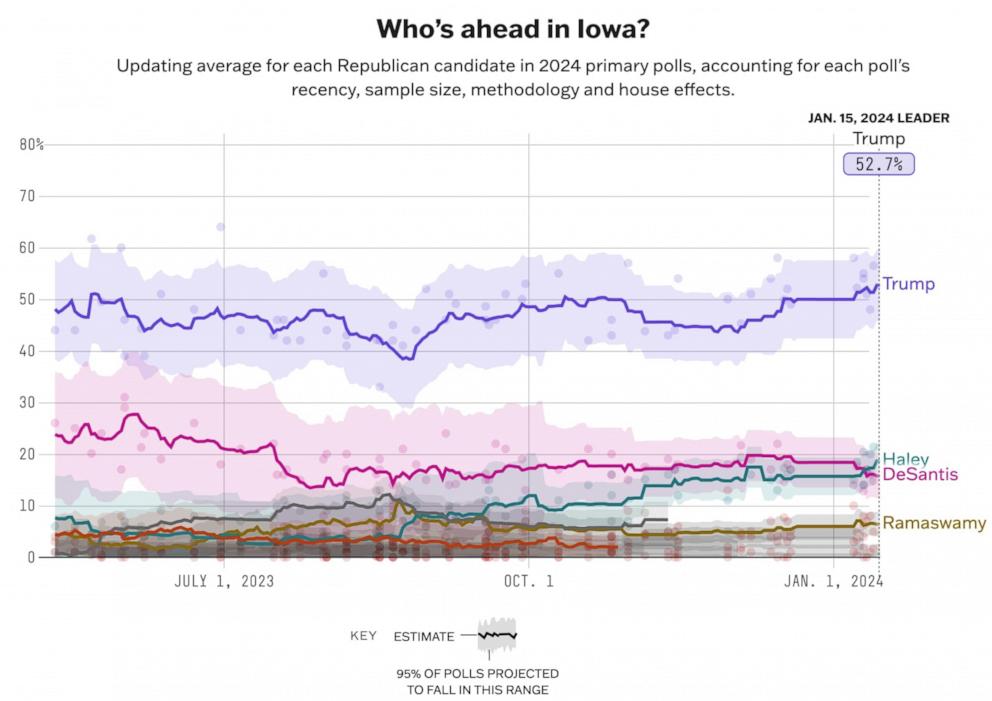
Iowa caucus entrance polls, while not a definitive predictor of the national election outcome, exert a significant influence on the presidential race. They offer early insights into candidate strengths and weaknesses, potentially shifting voter engagement and shaping the narrative surrounding the campaign. These polls are meticulously watched by candidates, campaigns, and the media, impacting the strategies and resources allocated during the crucial early stages of the race.
Impact on Voter Engagement and Interest
Entrance polls, by providing real-time feedback on candidate performance, can significantly impact voter interest. A strong showing in an entrance poll can generate excitement and encourage undecided voters to engage further. Conversely, a poor showing can lead to decreased interest and potentially a shift in voter support. This dynamic plays out not just among the general electorate, but also within specific demographics.
For example, a candidate’s strong performance among a particular demographic might draw in voters from that group, whereas a poor performance might lead to that group’s disinterest.
Effect on Candidate Strategies, Iowa caucus entrance polls
The results of Iowa caucus entrance polls directly influence candidate strategies and resource allocation. Candidates who perform well in the polls might shift their focus to other early primary states, potentially increasing their campaign spending in those areas. Conversely, candidates with poor performances might re-evaluate their strategies, potentially adjusting their campaign messaging or targeting different voter groups. This dynamic often plays out in the form of adjustments to campaign spending and personnel deployments.
Shaping the Campaign Narrative
Entrance polls play a critical role in shaping the narrative of the campaign. A candidate’s strong performance is often highlighted by the media, while a weaker showing might be scrutinized. This narrative development can significantly impact public perception of candidates and their viability. Positive coverage can lead to increased media attention and voter interest, while negative coverage can have the opposite effect.
Iowa caucus entrance polls are buzzing, and it’s fascinating to see how the early numbers stack up. The excitement is definitely building, and now that we’ve seen the results of the New Hampshire Democratic primary, results new hampshire democratic primary , it’s even more interesting to consider how these early indicators might influence the overall Iowa caucus entrance polls outcome.
The early voting numbers are certainly going to be a key factor as we head into the next phase of the election.
Impact on Media Coverage
Media coverage of candidates is profoundly affected by entrance poll results. Strong poll performances often translate to increased media attention, leading to more favorable coverage and potentially more in-depth analysis. Conversely, poor performances might lead to less favorable coverage or even a decline in media interest. This influence can be seen in the frequency and tone of news reports, particularly in the early stages of the race.
Correlation Between Entrance Poll Results and Final Election Outcomes
While a direct correlation between Iowa caucus entrance poll results and final election outcomes isn’t always clear-cut, there are some notable patterns that can be observed. The predictive power of these polls is limited, as numerous factors beyond early-state performance contribute to the final outcome.
| Year | Winning Candidate (Iowa Caucus) | Winning Candidate (General Election) | Correlation (Qualitative Assessment) |
|---|---|---|---|
| 2020 | Pete Buttigieg | Joe Biden | Limited |
| 2016 | Ted Cruz | Donald Trump | Limited |
| 2012 | Rick Santorum | Mitt Romney | Limited |
“Iowa caucus entrance polls, while valuable for initial insights, should not be viewed as definitive predictors of the overall presidential election outcome.”
Comparing Entrance Polls to Other Pre-Election Polls
Iowa caucus entrance polls offer a snapshot of voter sentiment at a specific moment in the election cycle. However, comparing them to broader national polls reveals important differences in their target populations and methodologies. Understanding these nuances is crucial for interpreting the polls’ implications for the overall presidential race.
Comparing Iowa Caucus Entrance Poll Results with National Polls
Analyzing the results of Iowa caucus entrance polls alongside national polls helps paint a more complete picture of the political landscape. Direct comparisons reveal potential divergences, which are often explained by the distinct characteristics of the samples and the methods used.
| Poll Type | Candidate | Result (Iowa Entrance) | Result (National) |
|---|---|---|---|
| Iowa Caucus Entrance Poll (Example) | Candidate A | 25% | 15% |
| Iowa Caucus Entrance Poll (Example) | Candidate B | 30% | 20% |
| Iowa Caucus Entrance Poll (Example) | Candidate C | 20% | 25% |
| National Poll (Example) | Candidate A | – | 15% |
| National Poll (Example) | Candidate B | – | 20% |
| National Poll (Example) | Candidate C | – | 25% |
Differences in Target Demographics and Methodologies
Entrance polls, by their nature, focus on individuals entering the caucus venue. This contrasts with national polls, which typically aim for a representative sample of the entire electorate. The difference in methodology is another key factor. Entrance polls capture opinions in real-time, while national polls often involve surveys administered over a longer period. This time-sensitive nature of entrance polls might reflect immediate and unfiltered opinions, potentially influenced by events leading up to the caucus.
Reliability of Entrance Polls Compared to Other Pre-Election Polling Data
The reliability of entrance polls hinges on the accuracy of the sample and the methodology employed. The inherent limitations of entrance polls include potential biases in the sample if not representative of the broader electorate. For example, voters choosing to attend the caucus may hold stronger views than those who do not attend. Conversely, national polls attempt to create representative samples but may struggle to capture the specific nuances of the election dynamics in a localized context.
Comparison of Accuracy of Different Poll Types and Methodologies
Various poll types employ different methodologies, affecting their accuracy. For instance, polls using random sampling techniques generally yield more reliable results compared to polls relying on convenience sampling. Entrance polls, while providing a snapshot, can be susceptible to biases associated with self-selection. National polls, with their broader reach, can better represent the overall electorate.
Evaluating the Credibility of Polling Organizations
Assessing the credibility of a polling organization involves evaluating several key aspects, including the organization’s methodology, the representativeness of its samples, and the transparency of its data collection procedures. A reputable organization should clearly articulate its methodology, disclose potential biases, and provide details on how its sample was selected. A review of past polling performance, examining how accurately predictions have aligned with election outcomes, provides another valuable metric.
This assessment requires careful analysis and consideration of multiple factors.
Iowa caucus entrance polls are always fascinating, but the recent news about midwife vaccinations and false immunization records in Nassau County is raising some serious questions. Are these issues related to the overall health of our communities, or could there be a deeper connection to the upcoming election? Perhaps the scrutiny surrounding these issues will influence voter turnout in the Iowa caucus entrance polls, and help people see the bigger picture of health and well-being.
Midwife vaccinations false immunization records nassau county It’s a complex situation, and it certainly adds another layer to the narrative surrounding the upcoming Iowa caucus entrance polls.
Visual Representation of Poll Data: Iowa Caucus Entrance Polls
Iowa caucus entrance polls offer a snapshot of candidate support as voters enter the caucuses. Visualizing these trends over time allows for a deeper understanding of the evolving race dynamic and potential shifts in support. Understanding how to effectively represent this data visually is key to recognizing patterns and predicting the race’s trajectory.
Poll Result Trends Over Time
Visual representation of poll results over time is crucial for understanding the evolution of candidate support. A line graph is an ideal choice to track the percentage of support for each candidate across multiple polls. The x-axis represents the poll date, and the y-axis shows the percentage of support. Each candidate’s support is represented by a distinct line, enabling a direct comparison of their performance.
Candidate Support Percentage Across Polls
This section presents a detailed breakdown of the percentage support for each candidate in each poll. A tabular format is well-suited for presenting this data.
| Poll Date | Candidate A | Candidate B | Candidate C |
|---|---|---|---|
| Jan 15, 2024 | 25% | 30% | 20% |
| Jan 18, 2024 | 28% | 28% | 20% |
| Jan 22, 2024 | 32% | 25% | 20% |
| Jan 25, 2024 | 35% | 22% | 15% |
This table showcases the fluctuating support for each candidate over the period leading up to the Iowa caucuses. The table clearly indicates the shift in support towards Candidate A from the initial polls.
Iowa caucus entrance polls are always fascinating, offering a glimpse into the early presidential race. While the numbers are still coming in, it’s worth noting that a recent hockey win, like the Oilers’ Stuart Skinner defeat of the Blue Jackets here , can sometimes shift the political landscape. Still, the polls are just one piece of the complex puzzle as we head towards the primary elections.
Effective Communication of Poll Data
Effective visual communication of poll data relies on clear labeling, appropriate scales, and a visually appealing design. Avoid clutter and ensure the data is easy to interpret at a glance. Color-coding is a powerful tool, with each candidate represented by a distinct color to make it easier to track their performance. Consistent formatting is essential to avoid confusion among viewers.
Types of Charts for Poll Data
Different aspects of poll data benefit from various chart types. Line graphs are ideal for tracking trends over time, as seen in the first example. Bar graphs are suitable for comparing the percentage support for each candidate at a specific point in time. Scatter plots might be useful to identify correlations between specific poll factors and candidate support, though this depends on the nature of the data being analyzed.
Detailed Description of Trends and Fluctuations
The visual representation of the data, as presented in the table, demonstrates the fluctuating nature of support for each candidate. For instance, Candidate A initially held a lower percentage of support compared to Candidate B. However, the data shows a clear upward trend for Candidate A as the polls progressed, suggesting a growing level of support over time.
The fluctuation in support for other candidates demonstrates the dynamic nature of political campaigns.
Impact on Voter Behavior and Campaign Strategies
Iowa caucus entrance polls, while not predictive of the national election, significantly influence voter behavior and campaign strategies. The immediate feedback loop of these polls allows candidates to adapt their messaging and resource allocation in real-time, shaping the narrative of the race. This dynamic interplay between poll results and campaign actions can dramatically impact the trajectory of a candidate’s presidential aspirations.
Influence on Potential Voter Decisions
Entrance polls, by highlighting candidate strengths and weaknesses, can sway potential voters. A strong showing in a particular demographic, for example, can encourage undecided voters to consider a candidate. Conversely, a poor showing in a crucial area could deter support. Candidates who consistently perform well in entrance polls often garner more media attention and perceived momentum, further influencing voter decisions.
This is particularly true for candidates who have not yet built significant name recognition.
Candidate Strategy Adjustments
Based on entrance poll data, candidates frequently adjust their campaign strategies. A candidate performing below expectations in a particular demographic might shift their messaging to better resonate with that group. This might involve targeting specific issues or emphasizing policy positions that are particularly appealing to that group. Conversely, candidates leading in certain segments may focus their resources on solidifying support in those areas, potentially through increased ground game activities or targeted advertising.
Iowa caucus entrance polls are buzzing, with a lot of anticipation about who’s going to emerge as a front-runner. Recent news about the political stars Harley Johnston, Oettinger, and Benn is certainly influencing the conversation. These rising figures are definitely adding a spark to the already electrifying atmosphere surrounding the polls, and their actions are being closely watched as the Iowa caucuses draw near.
Ultimately, the polls are a fascinating snapshot of where things stand in the race.
Impact on Campaign Resource Allocation
Entrance poll results directly influence the allocation of campaign resources. Candidates who perform strongly in early polls may receive more media coverage, which in turn can generate more fundraising opportunities. Conversely, candidates who perform poorly might see a reduction in media coverage and potential funding. Campaign staff and volunteers may be re-deployed to areas where the candidate is performing well or needs improvement.
Iowa caucus entrance polls are buzzing, but the recent Carroll verdict and its potential impact on Haley Trump’s campaign is definitely a factor. This is particularly interesting, given that some polls are already showing significant shifts in voter sentiment. The implications for the upcoming primaries, and how they might be affected by the ongoing political discussions, are worth watching closely, and it’s fascinating to see how this plays out in relation to the latest developments in the political climate.
For more on the Carroll verdict’s effect on Haley Trump, check out this analysis: carroll verdict haley trump. Ultimately, the Iowa caucus entrance polls will be crucial in shaping the race, and we’ll have to see how these events continue to affect the overall narrative.
Correlation with Fundraising Strategies
Poll data correlates strongly with fundraising efforts. Candidates performing well in early polls often see an uptick in donations, as supporters and donors are inspired by positive results. The perception of momentum, often fueled by favorable poll numbers, is a powerful motivator for fundraising. Conversely, if a candidate underperforms in a key demographic, fundraising may be hampered. This direct link between poll data and fundraising strategies is a critical component of a successful presidential campaign.
Strategies to Influence Poll Results
Campaigns employ various strategies to influence poll results. These strategies can range from carefully crafted campaign messaging to strategic voter outreach efforts. A candidate’s campaign team might specifically target key demographics with tailored messaging designed to maximize support. Targeted advertising and rallies in areas where the candidate is predicted to do well are common strategies to generate positive feedback in entrance polls.
These strategies can potentially alter the narrative and create a perception of momentum.
Potential Future Directions of Entrance Polls
Entrance polls, particularly those for the Iowa caucuses, are a crucial snapshot of voter sentiment. Their insights into candidate preference and voter motivations help shape campaign strategies and public perception. However, the methodology and application of these polls are always evolving. Future iterations will undoubtedly incorporate advancements in technology and data analysis.The field of polling is dynamic, constantly adapting to new information and refined techniques.
Entrance polls, as a vital component of pre-election analysis, will inevitably benefit from these ongoing innovations, potentially leading to more accurate and nuanced predictions of election outcomes.
Likely Improvements in Polling Methodologies and Technologies
Advancements in survey technology, such as online platforms and interactive interfaces, are expected to enhance the efficiency and accessibility of data collection. This could lead to faster results and greater participation, particularly among younger demographics. Real-time data analysis techniques will likely become more sophisticated, enabling near-instantaneous reporting and feedback to campaigns. Integration of social media data, alongside traditional polling methods, may provide a more comprehensive picture of public opinion.
Prediction for Information Included in Future Polls
Future entrance polls will likely expand beyond simple candidate preference to encompass factors influencing voter choice. The polls may include information on issues and policies that are important to voters, as well as demographic breakdowns, including more granular information on socioeconomic factors, education levels, and community engagement. This enhanced detail will offer a more nuanced understanding of the electorate and the reasons behind their decisions.
For example, future polls could capture voter attitudes towards specific policy proposals, allowing campaigns to tailor their messaging more effectively.
Potential Evolution of the Role of Entrance Polls in the Election Process
Entrance polls are more than just a predictor of the outcome; they are a dynamic tool that informs campaign strategies. Their evolution will likely see them playing a greater role in shaping the narrative of the campaign, with potential for real-time adjustments in campaign messaging and candidate positioning. For instance, if an entrance poll shows a strong surge in support for a specific candidate on a particular issue, campaigns may quickly adapt their messaging to highlight that issue.
Entrance polls may even influence the debate strategies of candidates.
Emerging Challenges in Collecting and Interpreting Iowa Caucus Entrance Poll Data
One persistent challenge is maintaining the representativeness of the sample, ensuring that it accurately reflects the entire electorate. Furthermore, the unique nature of the Iowa caucuses, with its relatively low voter turnout and specific demographics, requires careful consideration in interpreting the data. Maintaining consistency in polling methodology across different caucuses is also crucial to ensure accurate comparisons. Ensuring data quality and accuracy, given the inherent complexity of capturing voter decisions in real-time, is an ongoing challenge.
Potential New Approaches to Improve Accuracy and Reliability
To enhance accuracy, researchers could consider employing more sophisticated weighting techniques to adjust for differences in the sample’s demographic composition. Utilizing larger, more diverse samples, especially in capturing underrepresented groups, will help improve the overall reliability of the poll results. A more rigorous methodology that incorporates real-time feedback from the polling process could further enhance the accuracy of these polls.
This could involve using interactive tools during the caucus to gauge voter sentiment and understanding in a more granular fashion. For instance, polling questions could be tailored based on voter responses in real-time, allowing for a dynamic and more accurate picture of voter opinion.
Ultimate Conclusion
In conclusion, Iowa caucus entrance polls provide a snapshot of the presidential race’s early stages. By understanding their methodology, limitations, and historical context, we can better interpret their significance and influence on the broader election landscape. These polls offer valuable insights into voter sentiment, campaign strategies, and the evolving dynamics of the race. Ultimately, they serve as a crucial piece of the puzzle in understanding the unfolding presidential campaign.
Questions Often Asked
What are the typical demographics of respondents in these polls?
Typically, respondents are those actively participating in the Iowa caucuses. Demographics often reflect the overall composition of caucusgoers in a given year, though biases can exist due to participation rates.
How do entrance polls differ from other pre-election polls?
Entrance polls capture real-time sentiment from those directly participating in the caucuses, while national polls often survey a broader, representative sample of the population. The methodologies and target demographics are inherently different.
What are some common biases associated with Iowa caucus entrance polls?
Potential biases include self-selection bias (those who participate may differ from those who don’t), sampling bias (the sample may not accurately represent the entire electorate), and timing bias (the polls may reflect sentiment at a specific point in time).
How accurate are these polls compared to other pre-election polls?
The accuracy of entrance polls can vary, depending on factors like sample size, methodology, and the specific political climate. A comparison to other polls is necessary to assess reliability and potential limitations.



